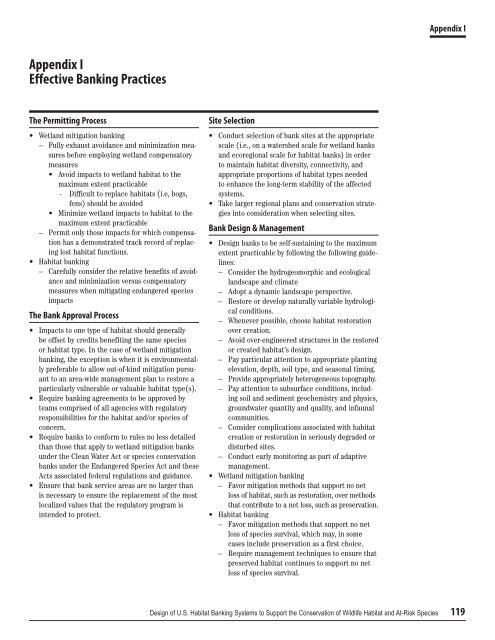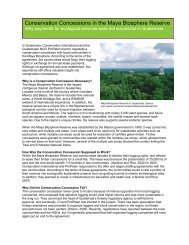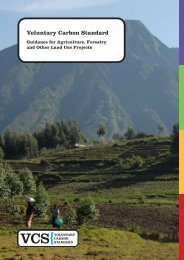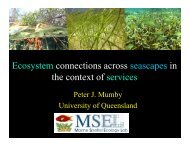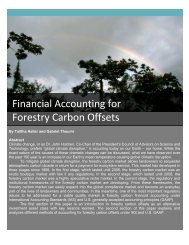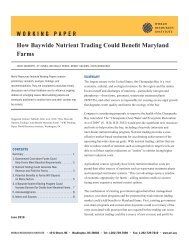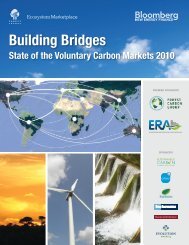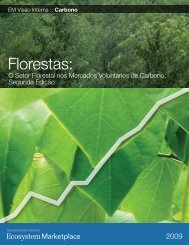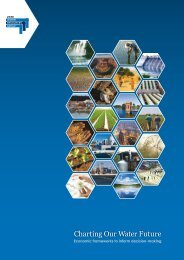Design of US Habitat Banking Systems to Support the Conservation ...
Design of US Habitat Banking Systems to Support the Conservation ...
Design of US Habitat Banking Systems to Support the Conservation ...
Create successful ePaper yourself
Turn your PDF publications into a flip-book with our unique Google optimized e-Paper software.
Appendix IAppendix IEffective <strong>Banking</strong> PracticesThe Permitting Process• Wetland mitigation banking– Fully exhaust avoidance and minimization measuresbefore employing wetland compensa<strong>to</strong>rymeasures• Avoid impacts <strong>to</strong> wetland habitat <strong>to</strong> <strong>the</strong>maximum extent practicable- Difficult <strong>to</strong> replace habitats (i.e, bogs,fens) should be avoided• Minimize wetland impacts <strong>to</strong> habitat <strong>to</strong> <strong>the</strong>maximum extent practicable– Permit only those impacts for which compensationhas a demonstrated track record <strong>of</strong> replacinglost habitat functions.• <strong>Habitat</strong> banking– Carefully consider <strong>the</strong> relative benefits <strong>of</strong> avoidanceand minimization versus compensa<strong>to</strong>rymeasures when mitigating endangered speciesimpactsThe Bank Approval Process• Impacts <strong>to</strong> one type <strong>of</strong> habitat should generallybe <strong>of</strong>fset by credits benefiting <strong>the</strong> same speciesor habitat type. In <strong>the</strong> case <strong>of</strong> wetland mitigationbanking, <strong>the</strong> exception is when it is environmentallypreferable <strong>to</strong> allow out-<strong>of</strong>-kind mitigation pursuant<strong>to</strong> an area-wide management plan <strong>to</strong> res<strong>to</strong>re aparticularly vulnerable or valuable habitat type(s).• Require banking agreements <strong>to</strong> be approved byteams comprised <strong>of</strong> all agencies with regula<strong>to</strong>ryresponsibilities for <strong>the</strong> habitat and/or species <strong>of</strong>concern.• Require banks <strong>to</strong> conform <strong>to</strong> rules no less detailedthan those that apply <strong>to</strong> wetland mitigation banksunder <strong>the</strong> Clean Water Act or species conservationbanks under <strong>the</strong> Endangered Species Act and <strong>the</strong>seActs associated federal regulations and guidance.• Ensure that bank service areas are no larger thanis necessary <strong>to</strong> ensure <strong>the</strong> replacement <strong>of</strong> <strong>the</strong> mostlocalized values that <strong>the</strong> regula<strong>to</strong>ry program isintended <strong>to</strong> protect.Site Selection• Conduct selection <strong>of</strong> bank sites at <strong>the</strong> appropriatescale (i.e., on a watershed scale for wetland banksand ecoregional scale for habitat banks) in order<strong>to</strong> maintain habitat diversity, connectivity, andappropriate proportions <strong>of</strong> habitat types needed<strong>to</strong> enhance <strong>the</strong> long-term stability <strong>of</strong> <strong>the</strong> affectedsystems.• Take larger regional plans and conservation strategiesin<strong>to</strong> consideration when selecting sites.Bank <strong>Design</strong> & Management• <strong>Design</strong> banks <strong>to</strong> be self-sustaining <strong>to</strong> <strong>the</strong> maximumextent practicable by following <strong>the</strong> following guidelines:– Consider <strong>the</strong> hydrogeomorphic and ecologicallandscape and climate– Adopt a dynamic landscape perspective.– Res<strong>to</strong>re or develop naturally variable hydrologicalconditions.– Whenever possible, choose habitat res<strong>to</strong>rationover creation.– Avoid over-engineered structures in <strong>the</strong> res<strong>to</strong>redor created habitat’s design.– Pay particular attention <strong>to</strong> appropriate plantingelevation, depth, soil type, and seasonal timing.– Provide appropriately heterogeneous <strong>to</strong>pography.– Pay attention <strong>to</strong> subsurface conditions, includingsoil and sediment geochemistry and physics,groundwater quantity and quality, and infaunalcommunities.– Consider complications associated with habitatcreation or res<strong>to</strong>ration in seriously degraded ordisturbed sites.– Conduct early moni<strong>to</strong>ring as part <strong>of</strong> adaptivemanagement.• Wetland mitigation banking– Favor mitigation methods that support no netloss <strong>of</strong> habitat, such as res<strong>to</strong>ration, over methodsthat contribute <strong>to</strong> a net loss, such as preservation.• <strong>Habitat</strong> banking– Favor mitigation methods that support no netloss <strong>of</strong> species survival, which may, in somecases include preservation as a first choice.– Require management techniques <strong>to</strong> ensure thatpreserved habitat continues <strong>to</strong> support no netloss <strong>of</strong> species survival.<strong>Design</strong> <strong>of</strong> U.S. <strong>Habitat</strong> <strong>Banking</strong> <strong>Systems</strong> <strong>to</strong> <strong>Support</strong> <strong>the</strong> <strong>Conservation</strong> <strong>of</strong> Wildlife <strong>Habitat</strong> and At-Risk Species 119


